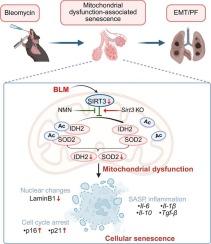Mitochondrial dysfunction-associated cellular senescence is partially involved in bleomycin-induced pulmonary fibrosis in mice
IF 3.4
3区 医学
Q2 PHARMACOLOGY & PHARMACY
引用次数: 0
Abstract
Accumulating data demonstrate that bleomycin (BLM), a clinically used antineoplastic drug, induces pulmonary interstitial fibrosis. However, the specific mechanism remains unclear. This study was carried out for the purpose of evaluating the effect of mitochondrial dysfunction-associated senescence on BLM-induced pulmonary fibrosis. Adult C57BL/6 J mice were intratracheally instilled with BLM (2.5 mg/kg). Pulmonary α-SMA and Vimentin, two indicators of epithelial-mesenchymal transition (EMT), were increased, and pulmonary collagen deposition was shown in BLM-treated mice. Pulmonary p16 and p21, two biomarkers of cell cycle arrest, were elevated, and pulmonary SASP indicators were up-regulated in BLM-treated mice. The reduction of mitochondrial area in BLM-treated mouse lungs was revealed by transmission electron microscopy. ATP content was reduced in BLM-treated mouse lungs. Pulmonary SOD2 and IDH2, two enzymes located in mitochondria, were decreased in BLM-treated mice. Sirtuin3 (SIRT3), an NAD+-dependent deacetylase located in mitochondria, was down-regulated in BLM-treated mouse lungs. Interestingly, Sirt3 gene knockout aggravated BLM-evoked mitochondrial dysfunction-associated senescence in mouse lungs. Sirt3 gene knockout exacerbated BLM-induced lung fibrosis. Conversely, nicotinamide mononucleotide (NMN), an NAD+ precursor, weakened BLM-induced down-regulation of mitochondrial SIRT3 activity in mouse lungs. NMN pretreatment attenuated BLM-induced mitochondrial dysfunction-associated senescence in mouse lungs. Finally, NMN pretreatment alleviated BLM-induced EMT and lung fibrosis. These results indicate that mitochondrial dysfunction-associated senescence partially contributed to BLM-induced pulmonary fibrosis.

线粒体功能障碍相关的细胞衰老部分参与了博莱霉素诱导的小鼠肺纤维化
越来越多的数据表明,博来霉素(BLM)是一种临床使用的抗肿瘤药物,可诱导肺间质纤维化。然而,具体机制尚不清楚。本研究旨在评估线粒体功能障碍相关衰老对blm诱导的肺纤维化的影响。成年C57BL/ 6j小鼠气管内灌注BLM (2.5 mg/kg)。肺上皮-间质转化(EMT)指标α-SMA和Vimentin升高,肺胶原沉积。在blm处理的小鼠中,肺p16和p21这两种细胞周期阻滞的生物标志物升高,肺SASP指标上调。透射电镜观察到blm处理后小鼠肺线粒体面积减少。在blm处理的小鼠肺中,ATP含量降低。blm处理小鼠肺内线粒体中SOD2和IDH2两种酶均降低。Sirtuin3 (SIRT3)是一种位于线粒体中的NAD+依赖性去乙酰化酶,在blm处理的小鼠肺中下调。有趣的是,Sirt3基因敲除加重了blm引起的小鼠肺部线粒体功能障碍相关衰老。Sirt3基因敲除加重了blm诱导的肺纤维化。相反,NAD+前体烟酰胺单核苷酸(NMN)减弱了blm诱导的小鼠肺部线粒体SIRT3活性的下调。NMN预处理可减轻blm诱导的小鼠肺部线粒体功能障碍相关衰老。最后,NMN预处理可减轻blm诱导的EMT和肺纤维化。这些结果表明,线粒体功能障碍相关的衰老部分促成了blm诱导的肺纤维化。
本文章由计算机程序翻译,如有差异,请以英文原文为准。
求助全文
约1分钟内获得全文
求助全文
来源期刊
CiteScore
6.80
自引率
2.60%
发文量
309
审稿时长
32 days
期刊介绍:
Toxicology and Applied Pharmacology publishes original scientific research of relevance to animals or humans pertaining to the action of chemicals, drugs, or chemically-defined natural products.
Regular articles address mechanistic approaches to physiological, pharmacologic, biochemical, cellular, or molecular understanding of toxicologic/pathologic lesions and to methods used to describe these responses. Safety Science articles address outstanding state-of-the-art preclinical and human translational characterization of drug and chemical safety employing cutting-edge science. Highly significant Regulatory Safety Science articles will also be considered in this category. Papers concerned with alternatives to the use of experimental animals are encouraged.
Short articles report on high impact studies of broad interest to readers of TAAP that would benefit from rapid publication. These articles should contain no more than a combined total of four figures and tables. Authors should include in their cover letter the justification for consideration of their manuscript as a short article.

 求助内容:
求助内容: 应助结果提醒方式:
应助结果提醒方式:


